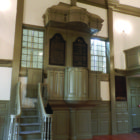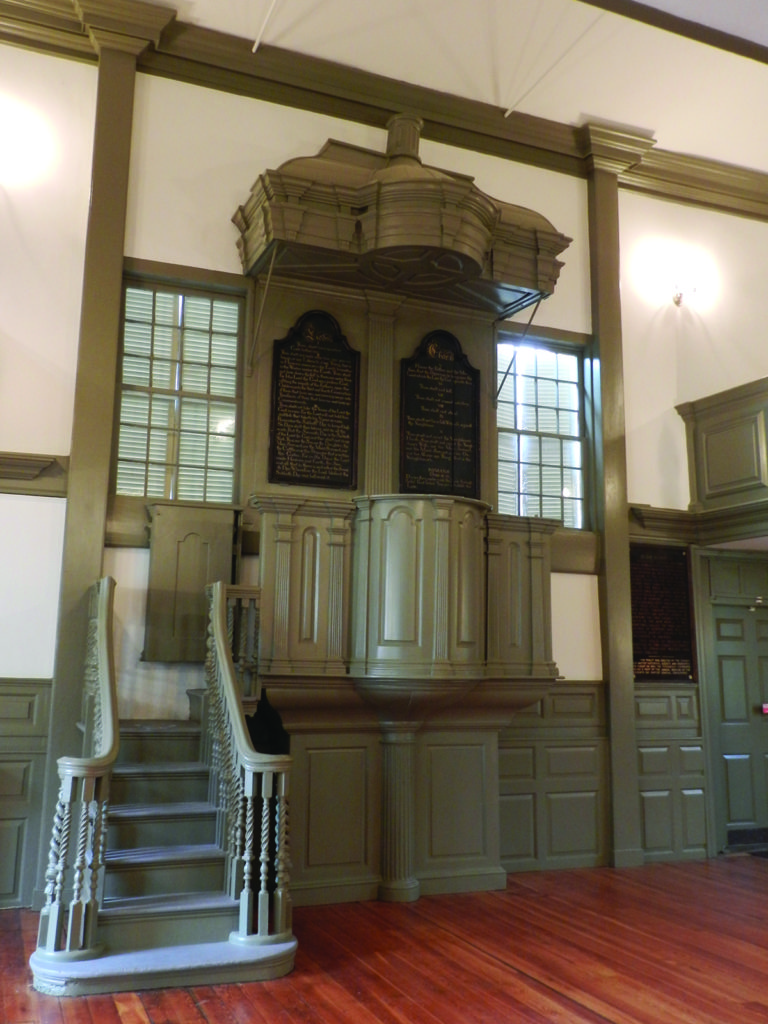
Jan 28, 2020
By Rev. Don A. Sanford
[Editor’s note: Given the theme of the publication this month, we have elected to print this previously unpublished work from the beloved (and now departed) SDB Historian Don A. Sanford.]
Few people in colonial times left as complete a record of the times and families as did Samuel Hubbard. Much of his journal was later used by such Baptist historians as Isaac Backus. Extracts copied from Hubbard’s journal are still considered a primary source of thought and actions of the last half of the seventeenth century. It is from this journal that we find an account of the 1549 Cramner New Testament in possession of the Seventh Day Baptist Council on History:
Now 1675, I have a testament of my grandfather
Cocke’s printed in 1549 which he hid in his bed-straw
lest it be found and burnt in Queen Mary’s days.1
Samuel was born to Dissenter parents in Mendelsham, England in 1610. Samuel’s paternal grandparents, Thomas Hubbard and wife, are listed in Foxe’s Book of Martyrs as having been driven out of the town of Mendelsham in 1556 for believing that Scripture contained enough information on its own to teach necessary doctrine to be saved.
Samuel emigrated to Salem, Massachusetts in 1633, and became acquainted with Roger Williams. The following year he moved to Watertown and became a member of the Congregational Church which had been organized there. Two years later, a large contingent migrated westward to the wilderness along the Connecticut River. They experienced considerable hardships from the weather as well as from unfriendly natives. But the journey was not all bad, because among the company was a young woman named Tacy Cooper from Dorchester who was able to cheer him up through all these difficulties.
After their marriage, the Hubbards made several moves. At Springfield, they were instrumental in gathering a church together. In 1647, they moved to Fairfield where they subscribed to Baptist ideas. Samuel gives his wife credit for taking the lead in this enlightenment:
God having enlightened both, but mostly my wife, into his holy ordinance of baptizing only visible believers, and being very zealous for it, she was mostly struck at and answered two times publicly; where I was also said to be as bad as she, and are threatened with imprisonment to Hartford jail, if not to renounce it or to remove; that Scripture came into our minds, if they persecute you in one place flee to another: and so we did.
In 1648, they moved to Rhode Island where they were baptized by John Clarke and joined his church, which had been established in 1644 as the second Baptist church in America. Samuel appears to have been recognized as a leader. In 1651, Samuel Hubbard was sent by the church “to visit the brethren who were in prison in Boston for witnessing the truth of baptizing believers only.” A few years later, he accompanied Obadiah Holmes on a mission to brethren on Long Island.
In 1668, a Baptist church under the leadership of Thomas Gould was established on Noodle Island in Boston Harbor. This was the first Baptist church of record in the Massachusetts Bay Colony. The Governor and Council of the colony “accounting themselves bound by the law of God and the Commonwealth to protect the Churches of Christ from the intrusion made thereby made upon their peace in the way of godliness,” had these Baptists arrested and put in prison. In order to correct them in their errors, they promised a “full and free debate” on the issues. Mr. Clarke’s church at Newport sent three men to help represent the imprisoned Baptists. Two of these had already accepted the Sabbath along with their Baptist beliefs: Samuel Hubbard and William Hiscox.
The record of the Hubbards’ acceptance of the Sabbath is recorded in Hubbard’s journal:
My wife took up keeping of the Lord’s holy 7th day Sabbath the 10 day of March 1665. I took it up 1 day April 1665. Our daughter Ruth 25 Oct. 1666 – Rachel – Jan. 15 day 1666. Bethiah – February 1666. Our son-in-law Joseph Clarke 23 February 1666.4
The exact circumstances of their coming to the Sabbath are not recorded. Since this happened shortly after the arrival from England of the Stephen Mumford family, who had been Sabbathkeeping members of Tewkesbury Baptist Church, it is generally assumed that the Mumfords were instrumental in bringing them to the acceptance of the Sabbath. Yet Seventh Day Baptists are not dependent upon an “apostolic succession” for the Sabbath. The question of the Sabbath was seriously debated in England during the Great Decade of the 1650s and could hardly have escaped notice by the people in the colonies who were in close communications with the mother country. In a letter written by Hubbard in 1669 to the church in Bell Lane, London, reference is made to books by Stennett, Cowell, and probably Saller, all leaders among the Sabbatarians in England. Stephen Mumford may have introduced members of the congregation to some of these writings and called Tacy and Samuel Hubbard to the concept of the Sabbath, but it was the study of the Scriptures which confirmed this belief.
By the end of the 1660s, there were eleven people within the congregation who had chosen to embrace the Sabbath. In addition, there were others, including John Crandall and Dr. Clarke’s nephew, Joseph Clarke, who had moved to the western part of the colony where several of Hubbard’s family had settled. In 1671, the first Seventh Day Baptist church in America was born. But as in any birth, there was a considerable time of gestation accompanied by discomfort and labor pains. In his biographical sketch of Obadiah Holmes, one of the chief antagonists of the Sabbatarians, Edwin Gausted commented upon this period:
The six years between Tacy Hubbard’s first apprehension of her Christian duty in 1665 and the final separation at the end of 1671 were years of painful decision and almost daily discomfort. From the Sabbatarian side, the questions were these: how much proselytizing of others within the church was appropriate? Could one still take communion with non-Sabbatarians? How much loyalty did the Hubbard family, for example, owe the church of Clarke and Holmes? How should one behave toward those who became Sabbatarians and then changed their minds?5
It was this last question which in the end forced a separation from the mother church. Two couples, Nicholas Wyld and John Salmon and their wives, had been among those who accepted the Sabbath, but in 1669 they left the Sabbath and even spoke against it within the church. The anxiety and discouragement which accompanied this “apostasy” (as it was viewed) is revealed in correspondence which Samuel Hubbard carried on with Sabbathkeepers in England, with members of his family in Westerly, and even with other Baptists in the colonies. When Obadiah Holmes preached a series of sermons accusing the Sabbathkeepers of leaving Christ to go to Moses, it became apparent that a split was inevitable.
Hubbard gave a little information in his journal about the immediate break stating simply:
We entered into a church covenant the 23rd day Dec., 1671, Wm. Hiscox, Stephen Mumford, Samuel Hubbard, Roger Baster, Sister Hubbard, Sister Mumford, Sister Rachel Langworthy.6
A John Comer manuscript among the Isaac Backus papers at the Rhode Island Historical Society Library contains the content of that covenant:
After serious Consideration and seeking God’s face among ourselves for the Lord to direct us in a right way for us, & our Children, so as might be God’s glory and our Souls good and others Example, We entered into Covenant with the Lord and with one another, and gave up ourselves to God and to each other, to Walk together in all God’s Holy Commandments and the Ordinances accord to What the Lord had Discovered & Should Discover to us, to be his Mind for us to be obedient unto; with Sence upon our Hearts of great need to be watchful over oneanother, Did promise to do, and in Building and Edyfying each other in our Most Holy faith.7
Nearly 350 years later, that covenant and the example of Samuel and Tacy Hubbard still provide incentive for Seventh Day Baptists to renew a covenant which upholds God’s Holy Sabbath.
From the Hubbards, we see many encouraging messages:
1. There is value in one’s heritage. We do profit from the ideals and examples of our ancestors.
2. Sometimes it is necessary to make moves for one’s conscience’s sake in order to have freedom to practice convictions.
3. Although history is often male-dominated, Tacy Hubbard is an example of countless women who have been spiritual leaders in their families. She was the first to accept the concept of adult baptism and the first to come to the Sabbath.
4. Samuel in his journal gave recognition to this fact, otherwise her role might have been neglected. Do we give women their rightful place in history?
5. The Hubbards symbolized the importance of the covenant relationship and Lord’s Supper.
6. Although they felt it necessary to break with their Baptist Church, their relationship remained cordial and cooperative.
7. They passed their convictions on to their children and grandchildren. Only three of their seven children lived to maturity, but what an impact those three had for Seventh Day Baptists through their families! Many Seventh Day Baptists with roots in the tradition can claim the Hubbards in their family trees, including the author of this piece!
1 Samuel Hubbard, Register of Mr. Samuel Hubbard, (copies in many locations; Backus transcription at Rhode Island Historical Society)
2 Hubbard, Register…, pg4-5
3 Edwin S. Gausted, Baptist Piety: The Last Will and Testament of Obadiah Holmes, Grand Rapids, MI: Christian UP, 1978, p22-30.
4 Hubbard, Register…p9-10.
5 Gaustad, Baptist Piety…p52-53.
6 Hubbard, Register…p10.
7 John Comer, “History of Baptists in Newport,” n.d., Isaac Backus Papers, MSS 273, B1, F2, Box 6, p2, Rhode Island Historical Society. [Note: there are slight variations between the exact text in the extant copies of the Newport SDB covenant.]


